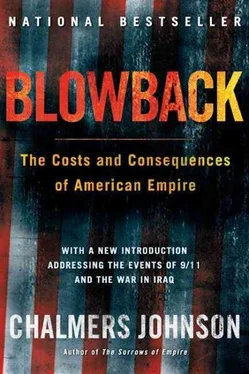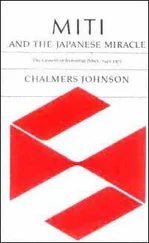Chalmers Johnson - Blowback, Second Edition - The Costs and Consequences of American Empire
Здесь есть возможность читать онлайн «Chalmers Johnson - Blowback, Second Edition - The Costs and Consequences of American Empire» весь текст электронной книги совершенно бесплатно (целиком полную версию без сокращений). В некоторых случаях можно слушать аудио, скачать через торрент в формате fb2 и присутствует краткое содержание. Год выпуска: 0101, ISBN: 0101, Издательство: Macmillan, Жанр: Старинная литература, на английском языке. Описание произведения, (предисловие) а так же отзывы посетителей доступны на портале библиотеки ЛибКат.
- Название:Blowback, Second Edition: The Costs and Consequences of American Empire
- Автор:
- Издательство:Macmillan
- Жанр:
- Год:0101
- ISBN:9780805075595
- Рейтинг книги:5 / 5. Голосов: 1
-
Избранное:Добавить в избранное
- Отзывы:
-
Ваша оценка:
- 100
- 1
- 2
- 3
- 4
- 5
Blowback, Second Edition: The Costs and Consequences of American Empire: краткое содержание, описание и аннотация
Предлагаем к чтению аннотацию, описание, краткое содержание или предисловие (зависит от того, что написал сам автор книги «Blowback, Second Edition: The Costs and Consequences of American Empire»). Если вы не нашли необходимую информацию о книге — напишите в комментариях, мы постараемся отыскать её.
Blowback, Second Edition: The Costs and Consequences of American Empire — читать онлайн бесплатно полную книгу (весь текст) целиком
Ниже представлен текст книги, разбитый по страницам. Система сохранения места последней прочитанной страницы, позволяет с удобством читать онлайн бесплатно книгу «Blowback, Second Edition: The Costs and Consequences of American Empire», без необходимости каждый раз заново искать на чём Вы остановились. Поставьте закладку, и сможете в любой момент перейти на страницу, на которой закончили чтение.
Интервал:
Закладка:
In July 1955, the occupation of Austria came to an end; the last Soviet units left Vienna on September 19, 1955. Immediately preceding the signing of the Austrian peace treaty, the USSR and its seven people’s democracies united in the Warsaw Pact, aimed at NATO and a “remilitarized Western Germany.” Under the terms of this alliance, the Soviet Union stationed its 2nd and 17th Mechanized Divisions, with a strength of about twenty thousand men and six hundred tanks, in Hungary.
Rakosi and the Communists ruled Hungary with an iron hand, utilizing mainly the hated State Security Police (the AVH) to crush all dissent. In June 1949, in an interparty struggle, Rakosi arrested the foreign minister, Laszlo Rajk, charged him with an attempt to overthrow the “democratic” order, and had him hanged. Six years later, in March 1956, following the 20th Congress of the Communist Party of the Soviet Union, at which Soviet Premier Nikita Khrushchev revealed the extent of Stalin’s tyranny, Rakosi made a similar move to de-Stalinize his own country. He revealed that Rajk had been condemned on “fabricated charges.” No doubt Rakosi’s mistake was that he was still in political control and revealing his own, rather than someone else’s, criminality. Widespread protests followed, and the Russians ousted Rakosi in July 1956, replacing him with Erno Gero, a party hack who did not last out the year. In October 1956, Laszlo Rajk and other victims of the 1949 purge trials were ceremonially reburied, with large Hungarian crowds in attendance.
The autumn of 1956, following the Soviet 20th Congress, saw the first “thaw” in the Communist world. China launched its campaign to “let a hundred flowers bloom” (that is, to invite criticism of the regime); Poland took its first tentative steps toward greater independence from the USSR; and in Hungary, starting with Rakosi’s fall, people looked forward to a softening of the regime. This mood lasted no more than a year anywhere in the Communist world, but at the time optimism was prevalent. Gero’s regime ordered an end to the compulsory teaching of Russian in Hungarian schools and some other cosmetic reforms. Students and intellectuals felt bold enough to meet and discuss such subjects as ending single-party rule and asking Soviet troops to go home. They called for the return to power of Imre Nagy, who had been premier from 1953 to 1955, following the death of Stalin, and was reputedly a moderate. An old Communist, a member of the party since 1918, Nagy had lived in Moscow for some fifteen years and returned to Hungary with the Red Army in 1944. His moderation consisted primarily of opposition to the secret police and their activities. Rakosi had attacked Nagy as a deviationist and had him expelled from the party.
On October 23, 1956, in the new atmosphere of mild intellectual ferment and optimism, an incident occurred in downtown Budapest that led to a general insurrection and the mobilization of Russian forces in Hungary. The State Security Police, intensely unpopular and universally feared, opened fire on a crowd of demonstrators and killed a number of students. In the melee that ensued, ambulances with red crosses sped to the scene; when their doors opened, AVH reinforcements dressed in the white coats of doctors but armed with machine guns emerged from them. 5Outrage over the killings and deception led to the Budapest uprising.
Over the succeeding five days fighting broke out between students and workers wielding Molotov cocktails and Soviet tanks trying to negotiate the narrow streets of Budapest. Not a single instance was recorded of Hungarian troops fighting on the Soviet side against their fellow countrymen. Even the Soviet troops themselves seemed reluctant to push forward with the attack. As the U.N. report noted, “Soviet forces normally stationed in Hungary or Romania had been affected by their surroundings. . . . The civilians whom they fought included women, children, and elderly people. [Soviet troops] could see that the people were unanimous in their fight against the AVH and foreign intervention; that the men whom the Soviet Army was fighting and the prisoners who were captured were not fascists, but workers and students, who demonstrably regarded Soviet soldiers not as liberators, but as oppressors.” 6
On the morning of October 24, Imre Nagy, having been readmitted to the party a week earlier, was elected to the Politburo and hastily appointed prime minister. It was a gesture designed to calm the crowds, which by then had broken the power of the AVH, while the Soviets were taking losses in the street fighting. The events of October 24 and 25 were extremely confused, and people did not know whether Nagy was actually in power or even whether he was fully on their side until later in the month. On October 25, Janos Kadar replaced Gero as first secretary of the party, and Gero fled to the USSR. Only on October 27 was Nagy finally able to form a government, into which he invited both Communists and non-Communists as ministers. The people of Hungary then accepted Nagy as their leader, having concluded that although he was a Communist he was also a good Hungarian. In the few days remaining to him, Imre Nagy ordered a cease-fire (which the insurgents honored), asked the Soviet Union to withdraw its forces from Hungary, ordered the AVH abolished, released all political prisoners, withdrew his country from the Warsaw Pact, and asked the international community to defend Hungary’s neutrality. This was obviously far more than Khrushchev and the other Soviet leaders had bargained for or were prepared to countenance.
On November 4, 1956, at 5:20 in the morning, Nagy announced over Radio Budapest that Soviet forces in battle formation had invaded the city with the intent to overthrow the legal government of Hungary. This second Soviet attack, using troops from central Asia who had been led to believe that they were being sent to Egypt to fight against British and French “imperialists,” was swift and thorough. 7By eight A.M. that same morning, Soviet tanks were in control of the Danube bridges. Imre Nagy, Laszlo Rajk’s widow, and several other democrats and women and children sought refuge in the Yugoslav embassy. The Soviet Union promised them safe passage out of Hungary, but the bus taking them from Yugoslavia’s embassy delivered them not to the border but to the headquarters of the Soviet military command. They were never heard from again. In 1958, the Hungarian government announced that Nagy had been secretly tried and executed.
Janos Kadar entered the Hungarian capital in the baggage train of the Soviet invaders and re-created single-party rule under the Hungarian Workers Party. Kadar and the USSR announced to the world that they had successfully prevented an attempt “to overthrow socialism in Hungary and to restore the capitalists and landowners to power.” Kadar thanked the Soviet Union for its assistance in defeating the “reactionary forces.” All fighting in Hungary was over by November 6, although in the interim some 190,000 students, liberals, and intellectuals managed to flee the country via Austria. The Soviet Union also deported a large but unknown number of Hungarians to the gulags of Russia.
In Korea, the roots of the Kwangju rebellion went back to General Park Chung-hee’s coup d’état of 1961. The previous year, students protesting Syngman Rhee’s flagrant corruption and rigged elections had brought down his regime. However, the democratic government they created was ineffective. Park, a graduate of a Japanese military academy in Manchuria, staged a military coup. Once in power he announced as his goals the end of South Korea’s extreme dependence on American economic aid and restoring relations with Japan. His economic reforms succeeded beyond anyone’s wildest dreams, surprising the Americans in charge of Korean affairs, who despite the evidence from Japan refused to believe that authoritarian guidance of the market could produce high-speed economic growth.
Читать дальшеИнтервал:
Закладка:
Похожие книги на «Blowback, Second Edition: The Costs and Consequences of American Empire»
Представляем Вашему вниманию похожие книги на «Blowback, Second Edition: The Costs and Consequences of American Empire» списком для выбора. Мы отобрали схожую по названию и смыслу литературу в надежде предоставить читателям больше вариантов отыскать новые, интересные, ещё непрочитанные произведения.
Обсуждение, отзывы о книге «Blowback, Second Edition: The Costs and Consequences of American Empire» и просто собственные мнения читателей. Оставьте ваши комментарии, напишите, что Вы думаете о произведении, его смысле или главных героях. Укажите что конкретно понравилось, а что нет, и почему Вы так считаете.










